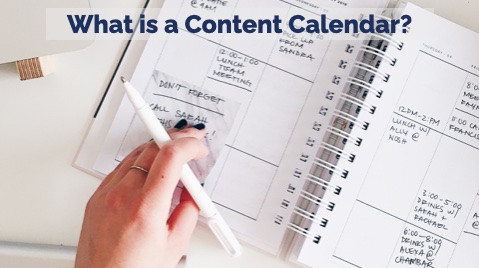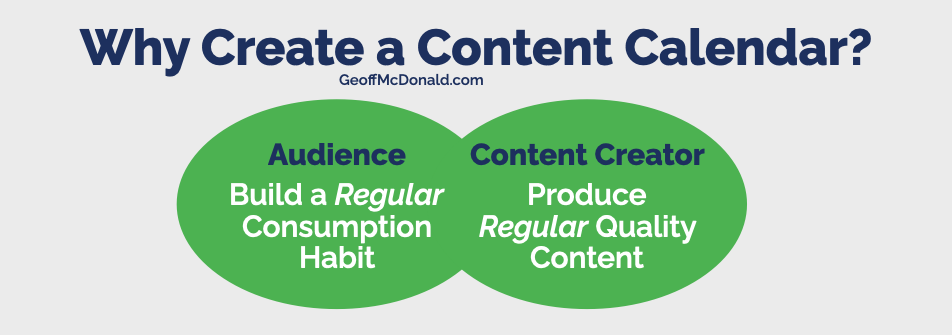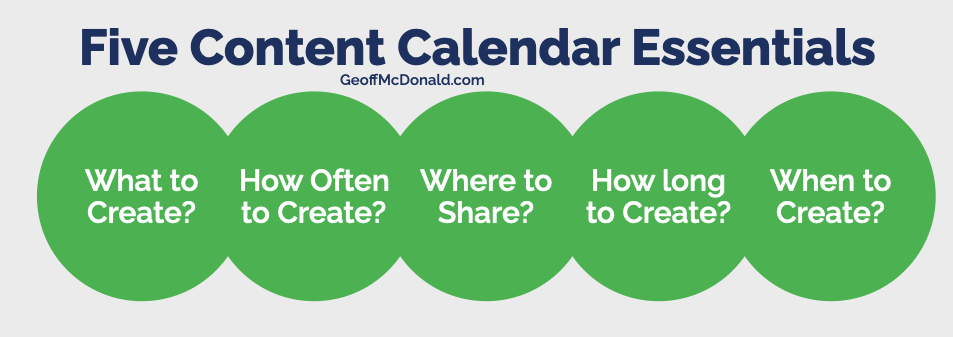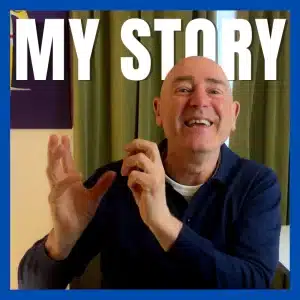How to create a content calendar that earns you money
The biggest challenge for all content creators is to know what to create and when to create it. Preplanning your content creation with a content calendar solves this problem.
But the way most people create their content calendar is flawed because they focus on the individual pieces of content.
In this post, I’ll show you how to earn money from your content by using an obvious secret.
Why you should create a Content Calendar
There are two big reasons for creating a content calendar.
The first is my Mum’s experience. Every morning she has the newspaper delivered. This means when she gets out of bed she must walk out to the front of the house and find the newspaper. Usually, the paperboy throws it into the bushes. Then she unravels the plastic, walks inside, puts on the kettle, makes a hot cup of tea and then sits down and reads the paper. She’s been doing the same thing every day for decades. It’s a daily ritual.
You want to create a content calendar so your audience can get into the habit of reading your news and ideas on a regular basis.
The second reason to create a content calendar is to produce consistent quality content. The easiest way to produce bad content is to create it at the last minute because you failed to plan what to write and when to write it.
Use a Content Calendar to deliver consistent quality content for your audience so they can make it part of their daily habit.
What is a Content Calendar?

Most people have a diary or schedule for their daily appointments.
Typically, it’ll say that you’re meeting with Reg on Friday at 4 pm at that coffee shop for one hour. Plus, you know it will take 30 minutes to travel so you add that into the diary entry too.
Your content calendar is just like this except for your content creation and publishing. Specifically, you will want to include:
- What content to create
- When and where it will be published
- The amount of time you need to create the content
Before you create your Content Calendar
Before you can start plotting time and space on your schedule for creating content, there are several things you must first decide upon. Effectively, you need to devise your Content Creation Strategy.
At the least, you need to define two things:
- Why are you creating content? This will be your reference point or benchmark for when that ugly thought of ‘why am I doing this?’ pops into your head. Yes, it will happen – and probably more than once.
- What specific outcome do you want to achieve? This gives you a target to focus on and a way to assess which tactics to use to achieve that goal.
Content Calendar versus Editorial Calendar
Traditionally, an Editorial Calendar showed what content you were going to create and when you were going to publish it. But for traditional media like a magazine or newspapers, you didn’t need to say where you were publishing it.
Nowadays, with so many choices about where to publish your content, a Content Calendar needs to add that extra step: where am I publishing this?
This is especially important when you may have different versions of the same content being shared. For instance, I’ll post an e-newsletter that includes the introduction to the blog post. Plus, I’ll publish a Linked In post that links to the blog post and video.
Five essential things your Content Calendar should include
There are five essential things your Content Calendar should include:
- What content are you going to create?
- How often are you going to create it?
- Where are you are going to share it?
- How long will it take to create?
- When are you going to create your content?
For example, I work in a weekly cycle and I publish:
- One video to post on my YouTube channel
- One blog post to post on my blog here at GeoffMcDonald.com
- One e-newsletter to my subscribers
- Three short posts on LinkedIn
From experience, I know this takes two full days to create, record, edit and publish. I usually record and edit the video over the weekend so I’m all ready for my main publishing date on Tuesday for the video, blog post and e-newsletter.
It also helps to define your Content Pillars, so you’ll know what topics to create your content around. Then it’s as simple as saying, I’m writing about this today and that next week.
What a Travel Writer taught me about a good Content Calendar
Many years ago, I attended a workshop by a freelance travel writer, and this is where I learnt the art of a good content calendar.
As a travel writer, he knew that it was all about the seasons. The obvious ones were winter and summer. But more specifically, it was also about when people travelled, the travel seasons. For instance, when it was cold in Melbourne in July, people headed to the warmer climates of Queensland, Bali, or Fiji.
But, more importantly, he knew that writing his article in July was not going to work – travellers needed time to make their plans plus editors of magazines needed even more time to plan their content. This meant pitching editors 6-9 months before the publication date of his article.
This is the true value of your content calendar – timing your content for when people need it the most.
Start to think about the events that happen each year in your industry and plan content for those moments.
Content Calendar Bonus Tip: The travel writer had a sneaky trick that saved him a lot of time and effort. Each year he knew what was coming. This meant he could re-pitch an updated version of his original article.
Content Calendar Example: Tax Accountant
For some businesses, there will be a natural rhythm to your content each year because of set events.
For instance, a Tax Accountant in Australia knows that the financial year ends on June 30. If you complete your own tax records, then you have until October 30 to submit your forms. And company tax returns are due on February 28.
Then if you look at some typical Content Pillars for Tax Accountants they might talk about:
- Record-Keeping – all year
- Tax Planning – all year
- Submitting your tax return – specific dates
This starts to form the skeleton for your 12-month content calendar.
Content Calendar Example: Thought Leader
As a thought leader or industry expert, you may not have such clear-cut dates throughout the year.
To develop your Content Calendar, you will need a different strategy – you’ll need to think like your audience.
Look through their lens of the world and ask: What are the seasons and events that impact them?
The better and deeper you know your client’s thoughts, the more easily you can match your content creation to what they need.
The second part to this is to know when to present your content to your audience. Like the travel writer, you need to know not just when people are going to travel but also when are they going to start to plan their travel. That’s when you want to present your ideas.
My Content Planning Example
For example, I know that my audience (and most people) are shutting down their business in December. They’re either flat out trying to finish things by the end of the year or they’ve given up and are already celebrating.
Then in January, people are in one of two places. Either they are away on holiday and don’t want to know about anything to do with work until the end of January, or they’re sitting at home wanting to start the new year with a bang.
For me (and many businesses) this is the time to offer strategy and planning. You can publish content about the need for this in December and offer programs in January and February.
The worthwhile strategy here is to pop up in a timely way when your potential clients most need you. For instance, if I’m about to plan for the year ahead and your fantastic new wonder content appears in front of me, then you’ll probably consider my coaching or course offering to help with you that. This is the whole point of content marketing.
But, in my view, if this is all that you do then you’ve wasted the opportunity.
Why most Content Calendar Strategies are a waste
The Content Calendar strategies I’ve shared so far will enable you to create and publish content that is timely for your audience, there is another way to multiply your results.
One of the downsides of creating content and publishing it, especially on social media, is that it is here today and gone tomorrow.
For instance, when you publish on Facebook, Twitter and LinkedIn your audience may see your content in their ‘stream’.
But it’s like standing on the side of the road watching a peloton of professional cyclists ride by. You wait for ages to be in the right position and then they flash by in seconds and head off down the road never to be seen again.
How to Develop a Content Calendar that Earns You Money
Given it can take an hour (or perhaps hours) to produce a piece of content if it is only going to be used once then that is a waste of your time, effort and energy.
It follows that one of my core principles for creating content is that it must be used multiple times. It’s called ‘re-purposing’. This is the key to developing a content calendar that earns you money.
It’s an obvious thing to repurpose your content and use it more than once. Most people do this in some way. But what most people do is simply repost the same piece or a modified version somewhere or sometimes else.
For me, this is still a waste.
The real secret to developing a Content Calendar that earns you money is to turn your content into something else – to turn it into a product or service that you can sell.
This is a double-whammy – you can promote your content to attract an immediate audience and you can also sell the same or similar content in a new package.
It’s one of those obvious secrets. It’s obvious once you hear it and it seems like a secret because nobody tells you to do it.
How to turn your Free Content into income-earning Products and Services.
The most common way to turn your free content into income-earning products and services is to turn your blog posts into a book. But to be honest, most books I’ve read that have been created in this literal way are disappointing because they don’t make a lot of sense. They’re just a jumble of posts cobbled together in one volume.
The problem with this approach is that you have your content creation strategy back to front. Instead of writing blog posts and putting them into a book format, it’s much better to devise the book format and then write your blog posts.
I did this with my book Weekly Done 1 and 2. I created a single page each week that I publish for my weekly newsletter. Then collected 52 weeks of content (52 pages) into a book. This became a year of content to help you get more done.
IMAGE – gif
My tip here is to start by designing the end product or service and then work backwards from that. Your Content Calendar then doubles as your Production Schedule for your product or service.
Three Examples of Free Content to Paid Products or Services
Here are three examples of creating free content that is also a paid product or service.
- Book from Blog Post – design the book format first then use the blog posts or Linked In posts to test your material. Typically, this means mapping out the core concepts or content pillars first.
- Book from Podcast – map out your book and record interviews with experts relative to your book. Publish the audio as a podcast and transcribe the material into words. Don’t just publish the transcripts of the interviews. Instead, shape the story of your book based on what your experts say.
- Courses from Videos – Similar to book from blog post – map out the overall course, then create individual videos and add an action guide or course manual. You may need to recreate the videos, but at least you’ll have the content chunks you need.
The big bonus of this approach is that you’ll have a compelling why driving your content creation each week as you step toward the bigger goal of creating a new fee-earning product or service.
Summary: How to create a content calendar that earns you money
Here are the key take-aways for creating a content calendar that earns you money:
- A Content Calendar can help you produce consistent quality content for your audience – to keep them in the habit of consuming your work.
- A Content Calendar is a diary or schedule of what content you will create, when you’ll create it and when you’ll publish it.
- Before you produce your Content Calendar be clear on your overall Content Creation Strategy.
- An Editorial Calendar says what to publish, but a Content Calendar also adds when and where you will publish it.
- The five essential things to add to your Content Calendar are: what, how often, where, how long and when.
- The travel writer lesson about content creation is that timing is everything.
- When planning your Content Calendar look through the lens of your audience at the seasons and events that impact them.
- Most Content Calendars are a waste because they fail to repurpose content effectively
- To earn money from your Content Calendar start by thinking about creating products and services. Then create your content.
More on how to create a Content Calendar
Here are three more resources to help you create a Content Calendar that earns you money:





